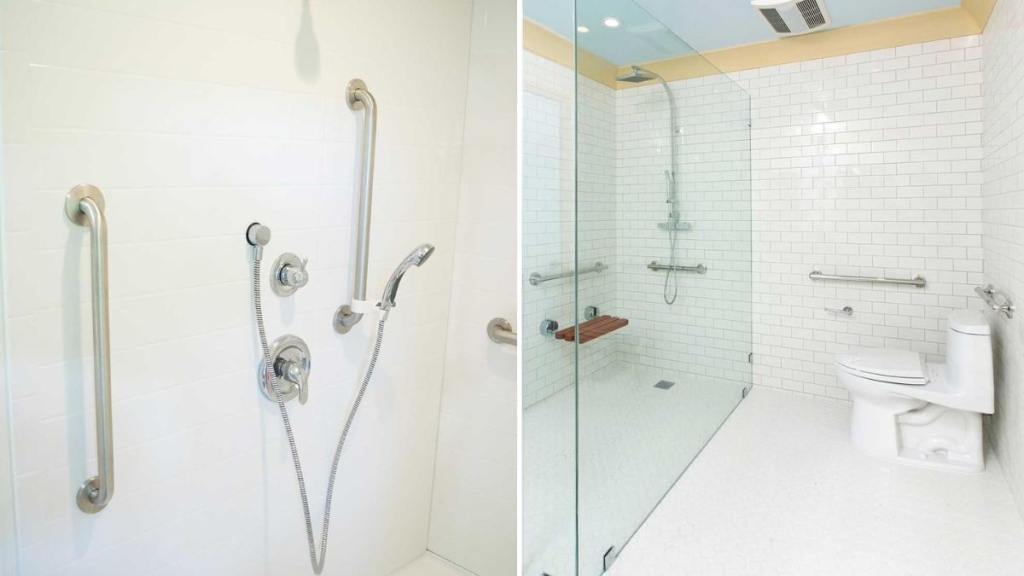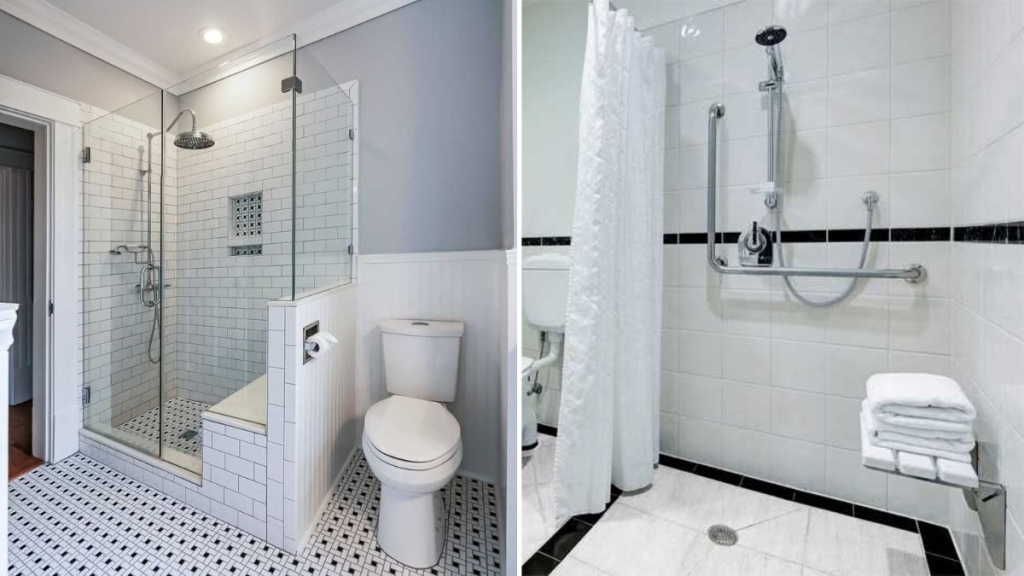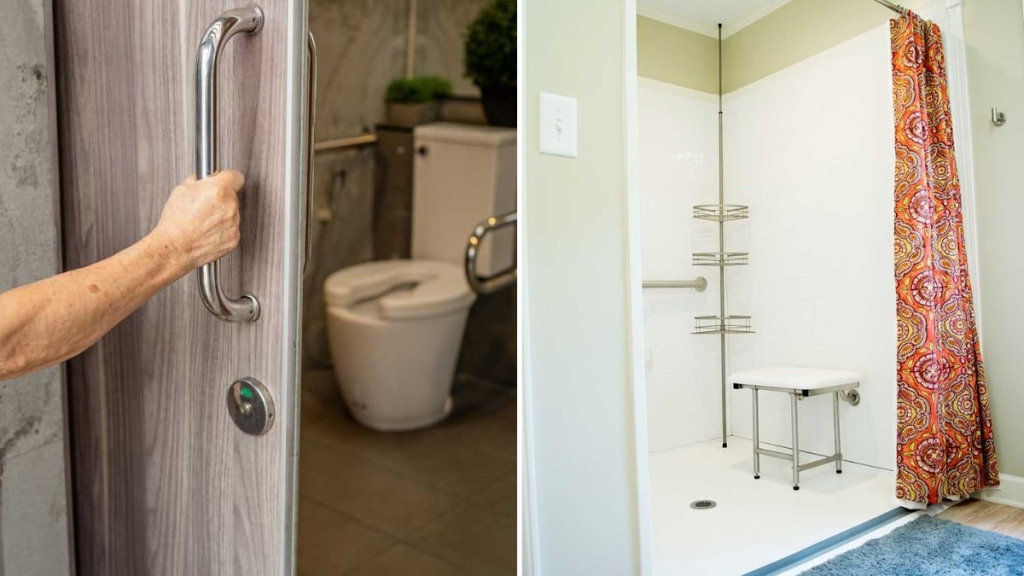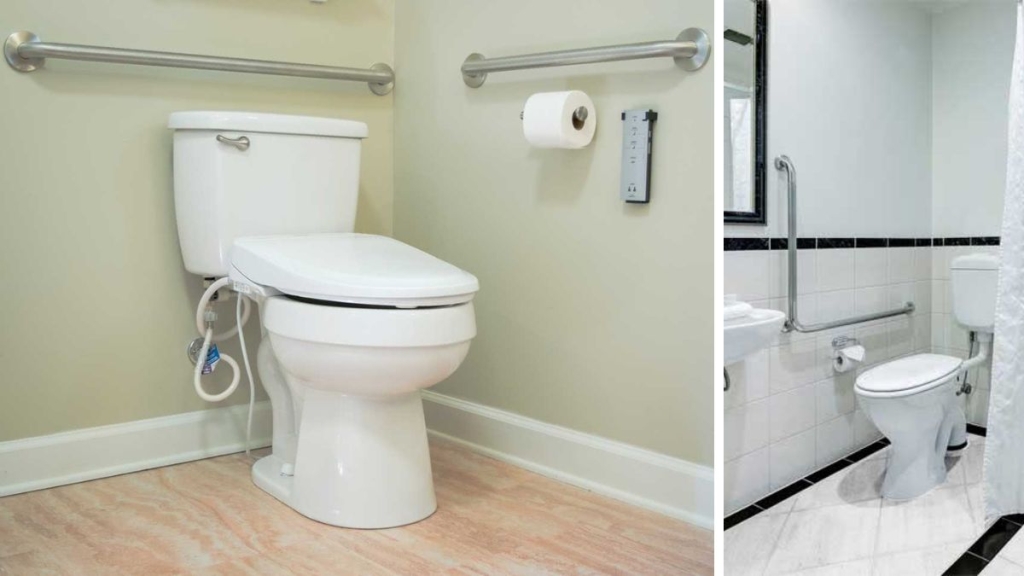When planning a safe and accessible home, the bathroom adapted for the elderly stands out as a priority. This space, often associated with the risk of falls and accidents, can be transformed into an environment of comfort and autonomy.
Through strategic adaptations and attention to specific details, it is possible to provide a safe bathing experience while maintaining the dignity and independence of our loved ones.
In this guide, we will explore the main aspects to consider when designing an adapted bathroom, ensuring a space that combines functionality, safety and aesthetics.
How important is a bathroom adapted for the elderly?
As we age, our bodies face challenges that can limit our independence. Factors such as decreased muscle mass can compromise balance. In addition to the natural changes that come with aging, common diseases at this stage of life, such as hypertension and diabetes, pose additional challenges. Given these factors, the need for adapted environments that offer safety and comfort becomes clear.

Autonomy is a valuable aspect of the well-being and self-esteem of older adults. Creating an environment where they can carry out their daily activities without constantly relying on help not only protects their physical integrity, but also promotes their mental health. Areas such as bathrooms are especially critical, as they contain a combination of factors that can increase the risk of accidents.
A properly adapted bathroom drastically reduces these risks. In addition to protecting against falls, a adapted bathroom It also ensures that the elderly person can use the space comfortably, maintaining their dignity and independence.
Technical standards for bathrooms adapted for the elderly
NBR9050 is a technical standard that provides guidelines for adapting bathrooms for people with special needs, including the elderly. Although it is mandatory in public spaces, its application in homes is optional, but highly recommended for those seeking to create a truly safe environment.
When planning a bathroom adapted for the elderly, it is essential to familiarize yourself with this standard. This will ensure that all modifications meet rigorous standards designed to maximize comfort and safety. The standard addresses several areas of the bathroom, from general dimensions to specific details such as the position and type of grab bars.
It is important to remember that, even in a private residence, following these guidelines is not just a matter of compliance, but rather a demonstration of commitment to the well-being of the elderly. By adhering to NBR9050, you are taking proactive steps to prevent accidents and ensure that the bathroom is accessible and comfortable for everyone.
Essential elements in an adapted bathroom

Overall dimensions
The dimensions of a bathroom adapted for the elderly are essential to ensure accessibility. It is important to consider not only the space for the elderly person to move around, but also the possibility of them being assisted by a caregiver or using assistive devices, such as a wheelchair.
The technical standard NBR9050 suggests a space of 180 cm x 180 cm as a basic dimension. This provides enough space to maneuver a wheelchair if necessary. The square format is often seen as the most suitable, as it maximizes usable space and facilitates movement.
When planning your space, it’s crucial to think about the flow of movement. This includes considering the position of each element, ensuring there is enough space to move between them without obstructions.
Doors
Accessibility starts at the entrance. Bathroom doors should be designed to allow easy entry and exit, especially if the elderly person uses assistive devices. A minimum width of 80 cm is recommended to ensure unobstructed access.
The way the door opens is also crucial. Doors that open outwards or sliding doors are ideal as they maximise the space inside. When opting for sliding doors, it is vital to ensure that there are no tracks on the floor as this can pose a tripping hazard.
In addition to functionality, door design can also be an aesthetic consideration. Choosing a door that complements the overall design of your bathroom will ensure that the space is not only functional but also aesthetically pleasing.
Shower box
The shower stall is one of the most safety-critical elements in a bathroom. It is often a damp space and can be slippery. When adapting a bathroom for the elderly, it is vital to ensure that the shower stall is spacious and safe.
A minimum recommended size is 90 cm x 95 cm. This not only ensures enough space for the senior to move around, but also allows for the possibility of a caregiver assisting with bathing. In many cases, seniors may need assistance, and a spacious shower will make it easier to do so without making either person feel confined.
In addition to the space, other elements, such as grab bars and non-slip flooring, must be incorporated into the shower enclosure to ensure maximum safety. Choosing the right floor material and installing the grab bars properly are essential to preventing accidents.
What does a bathroom adapted for the elderly need to have?

Supports and support bars
Grab bars are essential elements in a adapted bathroom. These supports provide a stable point of support, allowing the elderly person to move with more confidence and safety.
To be truly effective, these bars must meet specific standards. They must be robust and capable of supporting a significant amount of weight. The technical standard recommends that they support up to 150 kg. In addition to strength, the position and distance of the bars from the wall are vital to ensuring that they are accessible and useful.
Grabs are commonly installed near the shower stall and around the toilet. However, in larger bathrooms, it may also be beneficial to install additional grab bars along the walls. This provides additional support points, ensuring that the senior has something to hold on to as they move around the space.
Door handles and taps
Small details, such as doorknobs and faucets, can have a significant impact on the accessibility of a bathroom. In a bathroom adapted for the elderly, it is vital to choose designs that are easy to use, even for those with dexterity or strength limitations.
Handles that require turning can be difficult for some people. Instead, opt for lever models, which are easier to operate. Similarly, faucets that can be turned on and off with a simple movement are ideal. Faucets that require multiple turns or have small, difficult-to-grasp handles should be avoided.
In addition to functionality, you can find door handles and faucets that are also aesthetically pleasing. When adapting a bathroom, there is no need to compromise on design. With careful research and planning, you can create a space that is both functional and beautiful.
Toilet
The design and position of the toilet are central to a adapted bathroom. For many older adults, getting up from a traditional toilet can be a challenge. This is especially true for those with mobility or leg strength issues.
Raising the toilet can help make it more accessible. This can be achieved by adding raised toilet seats or by building a platform under the toilet. Regardless of the method chosen, it is vital to ensure that the toilet is at the right height for the elderly person.
Grab bars are essential around the toilet. They provide a point of support, allowing the elderly person to stand up and sit down more easily and safely. When installing these bars, it is important to ensure that they are at the correct height and distance to be truly useful.
Floors
The floor is undoubtedly one of the most safety-critical areas in a bathroom. A slippery floor is a significant risk, especially for older people who may already have balance or mobility issues.
When choosing flooring for a adapted bathroom, it is essential to choose non-slip materials. There are many options on the market, from ceramics to rubber, which offer good grip, even when wet. Avoiding polished or smooth surfaces is vital to reduce the risk of falls.
In addition to texture, floor design is also a consideration. In many bathrooms, the shower floor is slightly sloped to allow water to drain away. However, in an accessible bathroom, it is preferable to have a level floor. This reduces the risk of tripping and makes the space more accessible for those who use assistive devices, such as wheelchairs.
Lighting
Proper lighting is vital in any bathroom, but in a bathroom adapted for the elderly, is even more crucial. Many older people have vision problems, and poor or inadequate lighting can increase the risk of accidents.
Natural light is always the best option, if possible. However, not all bathrooms have this option. In such cases, it is vital to ensure that artificial lighting is bright and well distributed. Avoid shadows or dark areas, as this can create blind spots or risk areas.
Good lighting isn’t limited to just the ceiling. Consider adding additional lights in key areas, such as around the mirror, near the toilet, or in the shower stall. This will ensure that your senior always has a clear view, no matter where they are in the bathroom.
Motion sensor lights are also a great option. They ensure that the bathroom is always well lit when in use, without having to fumble for a switch. This is especially useful at night or for those who may have memory problems.
Bath chair
Even if the elderly person is relatively mobile, a shower chair can be a valuable addition to a adapted bathroom. It can provide a safe and comfortable place to sit while bathing, reducing the risk of falls.
When choosing a shower chair, it is vital to ensure that it is fit for purpose. It should be made from waterproof materials, be easy to clean and have non-slip feet. Stability is crucial, as any unexpected movement can be disorienting or dangerous.
For those who have a caregiver, a shower chair can also make the bathing process easier. It allows the caregiver to wash the elderly person more easily without having to worry about keeping them standing.
Shower register
The position of the shower valve is often overlooked, but in a adapted bathroom, is a crucial consideration. For many seniors, stretching or bending down to adjust the water temperature can be a challenge.
Positioning the register at an accessible height is vital. A height of around 4 feet from the floor is often ideal, as it is within reach of most people, whether they are standing or sitting in a wheelchair.
In addition to height, the design of the valve is also a consideration. Avoid designs that require a lot of strength or dexterity to operate. Valves with large levers or knobs are often the best option, as they are easy to use and adjust.
Rugs
While many bathrooms have decorative rugs, in one bathroom adapted for the elderly, it is vital to reconsider this choice. Regular rugs can be a tripping hazard, especially if they have edges that lift or move easily.
If you’re looking to add a rug to your bathroom, opt for a rubberized rug. These are designed to grip the floor firmly, reducing the risk of slipping or tripping. Also, make sure that any rug you choose is easy to clean, as hygiene is always a key consideration in the bathroom.
Color contrast
A visão é um dos sentidos que muitas vezes se deteriora com a idade. Para ajudar a compensar qualquer deficiência visual, é útil usar contrastes de cores em um adapted bathroom.
A clear contrast between the floor and walls can help make the space more navigable. This can help highlight specific areas, like the shower stall or toilet, making them easier to locate.
When choosing colors, consider the senior’s personal taste. An adapted bathroom doesn’t have to be clinical or boring. With the right choice of colors and materials, you can create a space that is both functional and aesthetically pleasing.
Customizing the adapted bathroom

While many of the above recommendations are general, it is important to remember that each senior is unique. They will have their own needs, challenges, and preferences. When adapting a bathroom, it is essential to consider the individual.
An open and honest conversation can be the best tool when planning a adapted bathroom. Ask the senior about their concerns, challenges, and desires. They may have valuable insights that can help guide the project.
Remember, the ultimate goal is to create a space that is safe, accessible, and comfortable. By listening to your senior and working with them, you can create a bathroom that meets all of these goals and more.
How much does an adapted bathroom cost?
Adapting a bathroom is an investment. However, it is an investment that is worth it, as it translates into safety, comfort and autonomy for the elderly.
The exact cost of renovating a bathroom will vary depending on the size of the space and the changes required. On average, a full renovation of a medium-sized bathroom can start at around R$14,000. However, this figure can vary.
When planning your budget, it’s vital to shop around and get multiple quotes. Working with qualified professionals is crucial, as this will ensure that all modifications meet safety and quality standards.
Did you like this amazing content? If so, share it with your friends and on your social networks. See exclusive and free content daily on our website. Blog of ideas and tips and take the opportunity to follow our Google News Channel. Thanks!